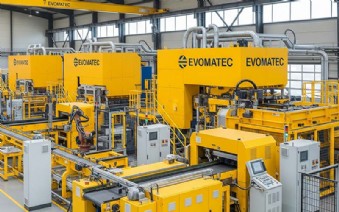-

Company
Product
ALUMINIUM MACHINES
PORTABLE MITER SAWS FOR ALUMINUM
PORTABLE COPY ROUTER MACHINES FOR ALUMINIUM
PORTABLE END MILLING MACHINES FOR ALUMINIUM
AUTOMATIC MITER SAWS FOR ALUMINIUM
COPY ROUTER MACHINES FOR ALUMINIUM
END MILLING MACHINES FOR ALUMINIUM
ALUMINUM CORNER CRIMPING MACHINE
DOUBLE MITRE SAWS FOR ALUMINIUM
AUTOMATIC SAWS FOR ALUMINIUM
BAR PROCESSING CENTERS
MACHINING CENTERS FOR ALUMINIUM COMPOSITE PANELS
NOTCHING SAWS
WEDGE CUTTING SAWS AND NOTCH CUTTING SAWS
MITER SAWS FOR ALUMINIUM
PVC PLASTIC MACHINES
PORTABLE MITER SAWS FOR PLASTIC
PORTABLE COPY ROUTER MACHINES FOR PLASTIC
PORTABLE END MILLING MACHINES FOR PLASTIC
MITER SAWS FOR PLASTIC
COPY ROUTERS FOR PLASTIC
END MILLING MACHINES FOR PLASTIC
WELDING MACHINES FOR PLASTIC
CORNER CLEANING MACHINES FOR PLASTIC PROFILES
DOUBLE MITRE SAWS FOR PLASTIC
BAR PROCESSING CENTERS
GLAZING BEAD SAWS
AUTOMATIC MITRE SAWS FOR PLASTIC
METAL MACHINES
MANUAL METAL SHEET BENDING MACHINE
MANUAL BENDING MACHINES
HYDRAULIC BENDING MACHINES
NON MANDREL BENDERS
PLATE BENDING MACHINES
BORDERING AND TRIMMING MACHINES
HORIZONTAL PRESSES
BELT GRINDING MACHINES
PIPE NOTCHING MACHINES
PIPE POLISHING MACHINES
LASER CUTTING MACHINES
PRESS BRAKES
VERTICAL TURNING CENTERS
MACHINING CENTERS
WOOD MACHINES
GLASS MACHINES
ROBOTICS SPECIAL MACHINERY
Service
Blog
Contact
Blog
- Home
- Blog
- BAR MACHINING CENTERS
- AUTOMATIC PROFILE PROCESSING
AUTOMATIC PROFILE PROCESSING

Automatic Profile Processing – Efficiency, Precision and Future Security
Introduction: Why Automatic Profile Processing Is Essential
Profiles made of aluminium, plastic and steel are indispensable in almost every industry: in window and door construction, façade systems, mechanical engineering, furniture production, automotive and even aerospace. To integrate these profiles reliably, they must be cut, drilled, milled, punched, threaded or deburred with absolute precision.
Manual processing is limited: it is time-consuming, error-prone, and costly. The solution is automatic profile processing – a technology that executes all steps digitally controlled, efficient, and reproducible.
What Does Automatic Profile Processing Mean?
Automatic profile processing refers to the use of CNC-controlled machines and fully automated production lines that handle profiles without manual intervention. Typical processes include:
-
Sawing (length and mitre cuts)
-
Drilling (mounting and pass holes)
-
Milling (slots, grooves, pockets, contours)
-
Punching and notching (for joints and weld prep)
-
Thread cutting (direct in the profile)
-
Deburring (smooth edges)
-
Automatic loading and unloading
The result: faster production, fewer errors, higher precision.
Advantages of Automatic Profile Processing
-
Maximum precision – CNC-controlled axes guarantee accuracy within hundredths of a millimetre.
-
Time and cost savings – multiple steps in one cycle → shorter production times, less labour.
-
Flexibility – suitable for aluminium, plastic and steel profiles.
-
Process reliability – automation reduces human error and scrap.
-
Sustainability – optimised cutting plans reduce material waste and energy use.
Applications
-
Windows: cutting and processing of frame and sash profiles.
-
Doors: drilling and milling for fittings, hinges and locks.
-
Façades: accurate profiles for structural elements.
-
Automotive & Aerospace: lightweight yet strong structures.
-
Mechanical engineering: special machine profiles.
-
Furniture: modern frames and modular systems.
Technology in Detail
-
CNC control: CAD/CAM import, cutting optimisation, storage of series programs.
-
Automation: tool changers, robotic handling, sensors for quality control.
-
Cooling/chip disposal: MQL lubrication, extraction, and conveyors.
Automatic vs. Manual Processing
-
Manual: slow, inconsistent, costly.
-
Automatic: up to 70% faster, highly consistent, cost-efficient.
Economic Impact
-
ROI within a few years.
-
Productivity gains up to +60–70%.
-
Competitive edge through faster delivery and higher quality.
Future Outlook
-
IoT connectivity for smart factories.
-
AI-driven CNC control for optimisation.
-
Digital twins for simulation and planning.
-
Green manufacturing with energy-efficient drives and recycling.
Conclusion
Automatic profile processing is a key technology that combines precision, efficiency, flexibility and sustainability. Companies investing in it gain clear competitive advantages and long-term future security.
- automatic profile processing
- profile processing cnc
- profile processing aluminium
- profile processing plastic
- profile processing steel
- automatic profile processing centre
- profile processing windows
- profile processing doors
- profile processing façades
- profile processing mechanical engineering
- profile processing furniture
- profile processing automotive
- profile processing aerospace
- automated profile machining
- profile processing with robots
- profile processing industry 4.0
- profile processing evomatec
- profile processing precision
- profile processing efficiency
- profile processing future technology
 GERMANY
GERMANY ENGLISH
ENGLISH FRANCE
FRANCE SPAIN
SPAIN PORTUGAL
PORTUGAL








